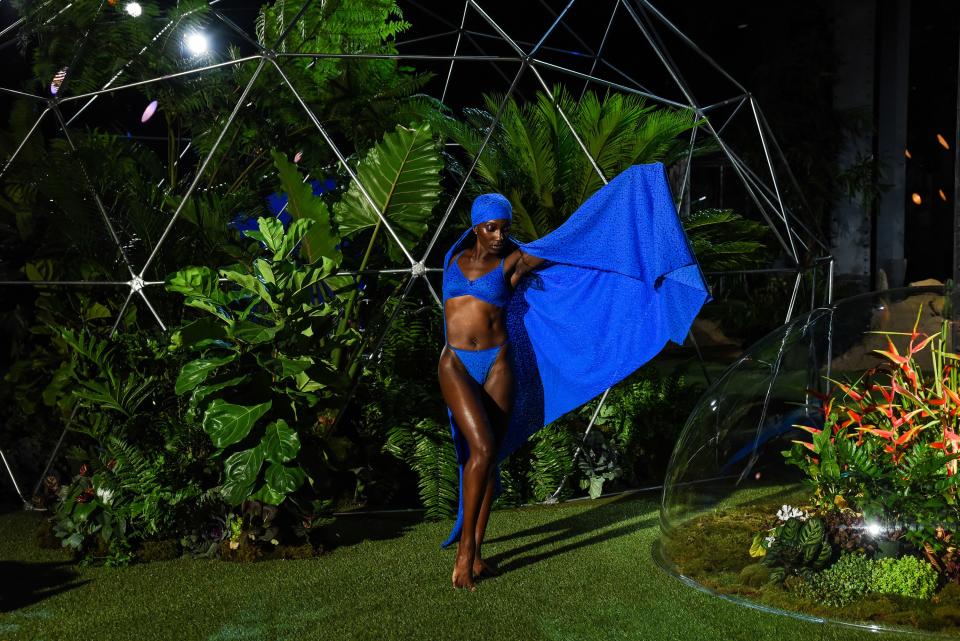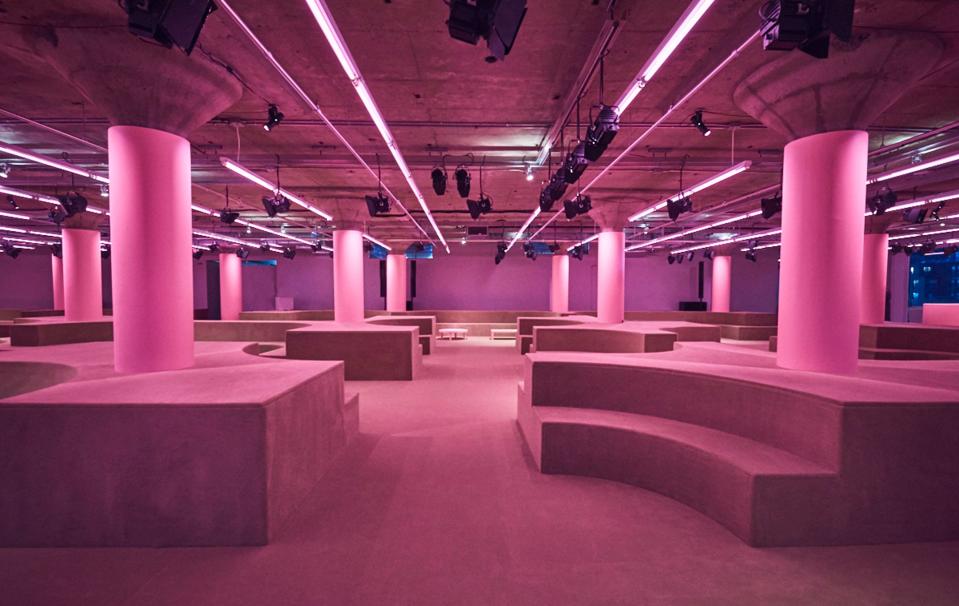What’s the Carbon Footprint of a Fashion Show? No One Really Knows
It’s pretty rare that a Google search will yield zero answers. But that’s precisely what I found after typing in: “What is the carbon footprint of a fashion show?” The page pulled up 8 million “results,” but none of them were relevant; most of the articles were about fashion’s carbon footprint as a whole, or they zero in on a specific material, like cotton, not the emissions of a standard runway show. It isn’t Google’s fault for not delivering what I wanted; the answers simply aren’t there. Maybe because we haven’t been looking for them.
If you had to guess, a fashion show probably isn’t a beacon of sustainability. Think of a major show in New York or Paris: It’s likely a 15-minute event planned months in advance, possibly in a historic venue or with a spectacular set, and probably ending with a dumpster of plastic water bottles, press notes, invitations, flowers, and decor. (To say nothing of the planes, trains, and automobiles required for everyone to actually get there.) But those impacts aren’t easily measured—at least not yet. “You can calculate the carbon footprint of a flight, but in terms of [the carbon footprint of] a fashion show, that data doesn’t exist,” Maxine Bédat, founder of The New Standard Institute, says. “I’ve reached out to my network [through NSI], and there just aren’t any resources. But considering the scale of the companies who are staging these shows, that isn’t a sufficient answer. If they put out a call for someone to help them find solutions or to stage a totally carbon-neutral show, the market would respond.”
Maybe brands aren’t putting those calls out because they haven’t needed to. It’s only now, with a perfect storm of climate change reports, the fires in the Amazon, and fashion’s new interest in sustainability, that we’re questioning the impact of everything. Last weekend, French President Emmanuel Macron unveiled his Fashion Pact at the G7 Summit, signed by the likes of Chanel, Gucci, Nike, and Burberry, which are committing to three ambitious sustainability goals. They’re reworking their supply chains, using organic materials, and experimenting with upcycling, among other measures—but twice a year (or four or six times), they’re also staging massive shows. Does that run counter to the strides they’re making everywhere else?

1032743282
You could make the argument that it’s impossible to be 100% sustainable and that something is better than nothing. Plus, for many brands (and the websites and magazines that cover them), Fashion Week is critical to success. As digital and social media evolves, shows have gotten bigger, to the point where they’re no longer just industry events. With the right models, celebrities, and setting, a runway show can generate millions of dollars in “media impact value,” which calculates the reach and resonance of social media coverage. (Last season, Christian Dior topped the list with an MIV of $17.4 million, according to Launchmetrics.) Perhaps this is simply the reality of Fashion Week in 2020: It has to resonate with people around the world, and you do that with a visually arresting spectacle, potentially in a far-flung destination. “With Instagram, you don’t just have 800 people in the room, you have 800,000,” Thierry Dreyfus, the founder of production company Eyesight, told me earlier this year. “Instagram has changed not only the way we think about light design, but the way we think about the set and how people are seated…. You have to [bring users] inside this specific world.”
In terms of attempting to do that in a conscious way, Keith Baptista, a founding partner of Prodject—which has produced shows for Chanel, Prada, Savage X Fenty, and Tom Ford—insists the next generation is already up to speed. “We have a younger team, and they’re very aware of what we do and how we do it,” he says. “They’re conscious of waste, how we’re recycling, how we can try to rent things as much as possible. We use green generators at events, and a lot of venues have Landpower [solar energy] that we can use directly. For lighting, we’ve gone heavily into LED, which are low-energy but still high-impact. And a lot of brands like Chanel, Gucci, and H&M have made corporate decisions to be more conscious, which helps us be more effective. They want to know how things are sourced, where we’re getting them, what happens to them after the event…. It’s been a dramatic difference over the past two or three years, where brands are stepping up and engaging in that way.”
Emmanuelle Rienda, the founder of Vegan Fashion Week in Los Angeles (set to take place in mid-October), cited similar strategies. “I love this topic because vegans get a lot of criticism for not being sustainable!” she says. “We’re supporting as many local designers as possible [in our shows and trade shows] to reduce transportation, and I’m not allowing vendors to bring extra lighting—we’re providing it, and we don’t want to use too much electricity. We’re renting all of the furniture so people aren’t transporting it here, and trying to keep it minimal. Our bags are biodegradable and made of cassava root, which bugs can eat. Our utensils and cups are eco-friendly, and we’re creating an app so the audience does’t need paper during the event.” She continues: “People think it’s more expensive to work this way, but I think it’s actually less costly. But it [does require] a lot of research and tiny tricks, and I think this should be someone’s role at the huge fashion weeks—to help take care of the sustainability side of the events and help with sourcing. That job doesn’t really exist.”
Even if every brand followed Baptista and Rienda’s lead and adopted their methods, there’s still the question of volume. “We need to address whether we really need all of these shows,” Tamara Cincik, the founder and CEO of Fashion Roundtable, says. “It’s relentless, and is it even working? Who buys this much stuff? I just don’t think the designer’s customer buys into the seasons like that anymore. I think the industry has to catch up to the new consumer, and a really big recalibration needs to happen. I’d like there to be a realization that we don’t have to follow fashion around the world like a headless chicken.”
The constant trans-continental travel might be one of the biggest problems. Any environmentalist will tell you that your eco-friendly efforts are shot to hell as soon as you board a flight; Swedish teenage eco-activist Greta Thunberg just spent two weeks on a sailboat to make that point. “I think the next area of focus will be on our travel,” Bédat says. “It’s insane to imagine the carbon footprint of getting everyone to one of these exotic locations for a Resort show. Fashion shows are supposed to point to the future, and if they’re ignoring the fact that we live in incredibly dangerous times with Greenland melting and the IPCC [Intergovernmental Panel on Climate Change] report telling us we have 10 years to figure it out…what are we saying about the future?” she says. “To ignore it kind of minimizes the role fashion plays.”

By this time next year, it’s possible that designers will be talking about their shows’ environmental impact as much as the efforts they’re making in their actual collections. If they’ve put the strategies Rienda and Baptista mentioned in place—like eliminating plastic, using low-energy lighting, choosing venues that offer solar, renting furniture, recycling decor and flowers, et cetera—then talking about and promoting them is the only way to elevate them to normalcy. It took the industry far too long to get behind sustainability in general, but if you look back on the early conversations around organic fabrics or ethical supply chains, the reason everyone started paying attention was because we kept talking about it. Shedding light on the issue is the first place to start—and hopefully the brands that signed Macron’s pact will be bold enough to start rethinking their shows, too.
Extinction Rebellion has taken issue with more than just the travel and energy use. They’ve called for London Fashion Week to be cancelled altogether, arguing that along with its carbon footprint, Fashion Week “creates the desire that results in the consumption of fast fashion and beyond. Fashion should be a cultural signifier of our times, and yet the industry still adheres to an archaic system of seasonal fashion, adding pressure to relentlessly create new fashion from new materials.” No, Fashion Week likely won’t be cancelled anytime soon, but XR’s goal to get people talking—and to collaborate on better solutions—is a worthy one. We’ve been talking about the jam-packed schedule for years, but never really took the possible environmental strain into consideration. If anything should get us to finally challenge the status quo, it’s that.
Originally Appeared on Vogue

